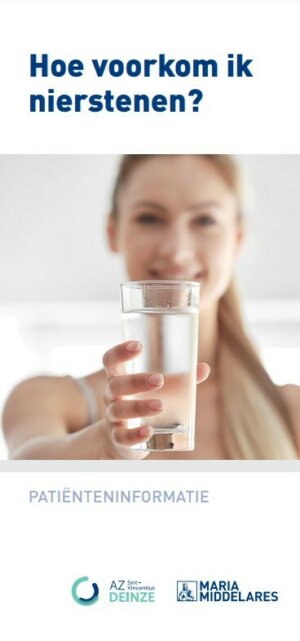Kidney stone
Symptoms and causes
Symptoms and causesWhat is it?
A kidney stone effectively means a stone or calcification located in the kidney, renal calyx or renal pelvis. A kidney stone is formed in the kidney. At some point, this stone may ‘break off’ and get stuck in the drainage system: in a renal calyx, at the exit of the renal pelvis or even further down the ureter itself. This stone blocks the flow of urine: it is only then that pain develops and the kidney stone becomes ‘palpable’.
Kidney stones are divided into two major categories: stones that contain calcium and stones that do not contain calcium. The majority of kidney stones contain calcium, along with another mineral such as phosphate or carbonate. Stones that do not contain calcium (e.g. uric acid stones, infection stones or cystine stones) have their own origin: in that case, there is a link with gout (uric acid stones), lingering urinary inflammation or a certain genetic abnormality (cystinuria). These stones, which do not contain calcium, have also their own therapy: some of these stones can be dissolved with medication and these show little or no signs under radiographic radiation, which sometimes complicates diagnosis and treatment.
Symptoms
When the flow of urine is blocked, (part of) the kidney expands and tension is created on the kidney capsule. This causes severe pain, known as renal colic. This pain occurs suddenly and the patient cannot find a comfortable position; this is called the urge to move. The pain is often accompanied by nausea and vomiting. If the stone shifts a little, the urine can flow again and the pain goes away.
Diagnosis and treatment
Diagnosis and treatmentPreventive measures
All types of kidney stone patients should (very generally speaking) follow the preventive measures below:
- Drink two to three litres a day. Most liquids are suitable for drinking, except grapefruit juice and water with added minerals.
- Eat a varied diet with lots of vegetables, fruit and fibre. Normal dairy intake is not a problem. Salt intake must be restricted. Be reasonable with your meat consumption.
How is the diagnosis made?
The diagnosis is made with an ultrasound, a CT scan of the abdomen and an intravenous urography.
Treatment
- Renal stone crusher (Extracorporeal Shock Wave Lithotripsy, ESWL)
- Percutaneous nephrolitholapaxy (PNL)
- Flexible ureteroscopy (FURS) or retrograde intrarenal surgery (RIRS)
Only available in Dutch:

Hoe voorkom ik nierstenen?
DownloadTreatment centres and specialisations
Treatment centres and specialisations
Latest publication date: 15/05/2024
Supervising author: Dr Ameye Filip



